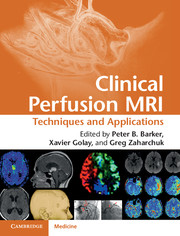Book contents
- Frontmatter
- Contents
- List of Contributors
- Foreword
- Preface
- List of Abbreviations
- Section 1 Techniques
- 1 Imaging of flow: basic principles
- 2 Dynamic susceptibility contrast MRI: acquisition and analysis techniques
- 3 Arterial spin labeling-MRI: acquisition and analysis techniques
- 4 DCE-MRI: acquisition and analysis techniques
- 5 Imaging of brain oxygenation
- 6 Vascular space occupancy (VASO) imaging of cerebral blood volume
- 7 MR perfusion imaging in neuroscience
- Section 2 Clinical applications
- Index
- References
2 - Dynamic susceptibility contrast MRI: acquisition and analysis techniques
from Section 1 - Techniques
Published online by Cambridge University Press: 05 May 2013
- Frontmatter
- Contents
- List of Contributors
- Foreword
- Preface
- List of Abbreviations
- Section 1 Techniques
- 1 Imaging of flow: basic principles
- 2 Dynamic susceptibility contrast MRI: acquisition and analysis techniques
- 3 Arterial spin labeling-MRI: acquisition and analysis techniques
- 4 DCE-MRI: acquisition and analysis techniques
- 5 Imaging of brain oxygenation
- 6 Vascular space occupancy (VASO) imaging of cerebral blood volume
- 7 MR perfusion imaging in neuroscience
- Section 2 Clinical applications
- Index
- References
Summary
Introduction
From the early start in history man employed “contrast media” to measure flow: Hero of Alexandria proposed for example in 62 AD the use of debris in combination with a sundial to calculate the velocity of the water in Egyptian rivers. Leonardo da Vinci improved this method by using a pig's bladder attached to a stick with a stone on the other side. Early implementations to measure cerebral blood flow similarly introduced a tracer upstream from the brain, such as nitrous oxide or xenon gas. Even before these early blood flow measurements, functional brain experiments were introduced by monitoring changes in brain volume upon functional activity as an indicator and proof of vasodilatation [1]. It is therefore not surprising that when contrast agents for MRI based on gadolinium chelates were introduced, blood flow measurements were among the first applications. Interestingly, in 1990, for the first time the possibility of localization of neuronal activation was shown using repeated injections of a bolus of contrast agent [2], two years before the BOLD (blood oxygenation level-dependent) effect emerged as the prime tool for functional MRI (fMRI) [3].
- Type
- Chapter
- Information
- Clinical Perfusion MRITechniques and Applications, pp. 16 - 37Publisher: Cambridge University PressPrint publication year: 2013
References
- 3
- Cited by



